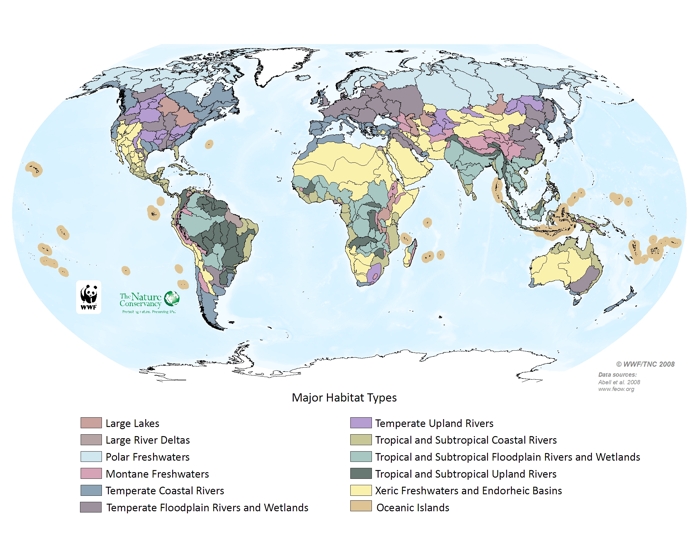
Major Habitat Types

The freshwater Major Habitat Types (MHTs) reflect groupings of ecoregions with similar biological,
chemical, and physical characteristics and are roughly equivalent to biomes for terrestrial systems.
The MHTs refer to the dynamics of ecological systems and the broad habitat structures that define
them, and these groupings can provide a structured framework for examining and comparing the
diversity of life in freshwater systems. Because of the large scale of ecoregions, all contain
patches of multiple habitat types. For instance, ecoregions in the large lakes habitat type can
contain swamps, floodplains, and grassy savannas in addition to the dominant lake habitat. Smaller
habitats cannot be mapped at the scale of the ecoregion map, but such habitat diversity contributes
to species and ecosysem process diversity within ecoregions. For instance, globally 99% of lakes and
ponds are less than 10 hectares in area.
Large Lakes are freshwater ecoregions that are dominated and defined by large lentic
systems.
Freshwater ecosystems in these ecoregions may include in-flowing and out-flowing rivers and various
peripheral wetlands in addition to the lakes themselves. This MHT includes large tropical,
temperate, and polar lakes, as well as Inland Seas included in this analysis (Aral and Caspian).
Examples include Lake Baikal in Siberia, Lake Malawi in Africa, or Michigan-Huron in North America.
Large River Deltas are freshwater ecoregions that are dominated and defined by deltaic features
(e.g., tidal influences) and their associated fish faunas, which are distinctive from those
occurring upstream. Examples include the Niger River Delta ecoregion and the Mekong River Delta
ecoregion. Ecoregions containing deltas but not defined by specific deltaic fauna, such as the Lower
Mississippi ecoregion, are not considered Large River Delta ecoregions.
Montane Freshwaters are freshwater ecoregions comprised of small streams, rivers, lakes or
wetlands
at higher elevations, regardless of latitude. These ecoregions include either high gradient,
relatively shallow, fast-flowing streams, with rapids or complexes of high-altitude wetlands and
lakes, and montane climatic conditions. Examples include Mount Nimba and Western Equatorial Crater
Lakes in Africa and Orinoco Piedmont and Andes Mountains in South America.
Xeric Freshwaters and Endorheic (Closed) Basins are freshwater ecoregions dominated by
endorheic
aquatic systems or freshwaters that are found in arid, semi-arid, or dry sub-humid environments.
These ecosystems tend to have specific fauna adapted to ephemeral and intermittent flooding regimes
or lower waters levels during certain times of the year. Examples include the lower Nile River, or
the Death Valley ecoregion in the US.
Temperate Coastal Rivers are freshwater ecoregions dominated by several small to medium coastal
basins in mid-latitudes (temperate). These ecoregions are characterized by riverine ecosystems, but
may also contain small lakes, coastal lagoons, and other wetlands. Migratory species that spend part
of their life cycles within marine environments may inhabit these ecoregions. Although floodplains
may occur along rivers within this MHT, the dominant features are numerous, small to medium-sized
basins that drain to the ocean,, instead of one large river predominating with an extensive fringing
floodplain.. This MHT also encompasses island ecoregions with these characteristics. Examples
include the North Pacific Coastal and South Atlantic ecoregions in North America.
Temperate Upland Rivers are freshwater ecoregions that are dominated and defined by
mid-latitude
non-floodplain rivers, including headwater drainages and tributaries of large river systems. These
rivers are characterized by moderate gradients and the absence of a cyclically flooded, fringing
floodplain. Examples include the Ozark Highlands and Ouachita Highlands in North America.
Temperate Floodplain Rivers and Wetland Complexes are freshwater ecoregions that are dominated
by a
single mid-latitude large river system, including the main stem river drainage and associated
sub-basins, which are either currently or were historically characterized by a cyclically flooded,
fringing floodplain. These ecoregions may also contain wetland complexes composed of internal
deltas, marshes, and/or swamps, associated with the main river system. Examples include the
Mississippi and Middle Missouri Rivers.
Tropical and Subtropical Coastal Rivers are freshwater ecoregions dominated by several small to
medium coastal basins at low-latitudes (tropics). These ecoregions are characterized by riverine
ecosystems but may also contain small lakes, coastal lagoons, and other wetlands. Although
floodplains may occur along rivers within this MHT, the dominant features are numerous, small to
medium-sized basins that drain to the ocean, instead of one large river predominating with an
extensive fringing floodplain. This MHT also encompasses island ecoregions with these
characteristics. Examples include Kenyan Coastal Rivers and Mata Atlantica.
Tropical and Subtropical Upland Rivers are freshwater ecoregions that are dominated and defined
by
low-latitude non-floodplain rivers, including headwater drainages and tributaries of large river
systems. These rivers are characterized by moderate gradients and absence of a cyclically flooded,
fringing floodplain. Examples include the Zambezian Headwaters, Upper Niger, and the Brazilian
Shield.
Tropical and Subtropical Floodplain Rivers and Wetland Complexes are freshwater ecoregions that
are
dominated by a single low-latitude large river system, including the main stem river drainage and
associated sub-basins, which are either currently or were historically characterized by a cyclically
flooded, fringing floodplain. These ecoregions may also contain wetland complexes composed of
internal deltas, marshes, and/or swamps, associated with the main river system. Examples include the
Lower Congo, Cuvette Central, Lower Niger-Benue, Amazonas Lowland, and Orinoco-Llanos.
Polar Freshwaters are freshwater ecoregions comprising entire drainages; from the headwaters to
mouth, and found in high latitudes. Examples include the Lena River in Siberia and the Yukon in
Alaska.
Oceanic Islands are freshwater ecoregions comprised of one or more islands completely
surrounded by
water, above high tide, and isolated from other significant landmasses. These ecoregions are
characterized by freshwater biotas derived from marine ancestors. Examples include Fiji and the
Hawaiian Islands.